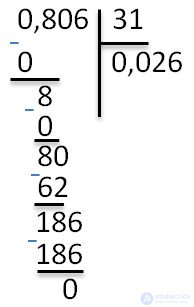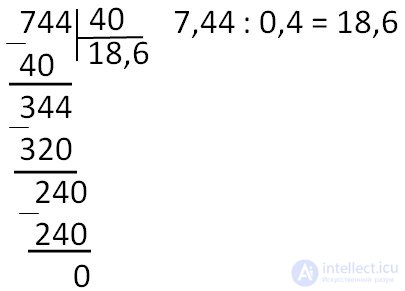Lecture
When dividing decimal fractions you may encounter several cases.
To divide the decimal fraction by a natural number, we use the following rules.


If the integer part of the dividend is less than the divisor, then in the private part we put 0 integers.
Example:
Note that the integer part of the decimal fraction (we have 0) is less than the divisor (31). Therefore, in the private we immediately put 0 in the whole part.

Do not forget to record the answer in the example:
To divide the decimal fraction by 10, 100, 1000, etc., you need to move the comma in this fraction to as many digits to the left as there are zeroes after the one in the divisor.
Examples:
Example:
We count the number of decimal places in decimal. We have one sign. So, to turn 2.5 into an integer, you need to multiply it by 10. Do not forget and the dividend multiply by 10.
5: 2.5 = (5 • 10): (2.5 • 10) = 50: 25 = 2
You can divide decimal fractions in different ways. We describe one of the possible. By tradition, a small plan of action:
Determine the fraction with the largest number of characters (digits) to the right of the comma.
Multiply both decimals by 10, 100, 1000, etc., to turn decimals into integers.
We divide ordinary numbers by the rules of division into a column and write the answer.
Example:

The greatest number of digits (figures) after the decimal point is in the first decimal fraction, so we focus on it. To turn 7.44 into an integer, multiply it by 100 (see multiplication of decimal fractions).
At 10, 100, 1000, etc. both decimals are multiplied.
And they are multiplied by the same number. That is, if you multiplied the first fraction by 10, then you must multiply the second by 10.

Multiply each of the decimal fractions by 100.

We divide ordinary numbers into a column and write the answer. Remember that we initially divided the decimal fractions .

Comments
To leave a comment
Arithmetic
Terms: Arithmetic